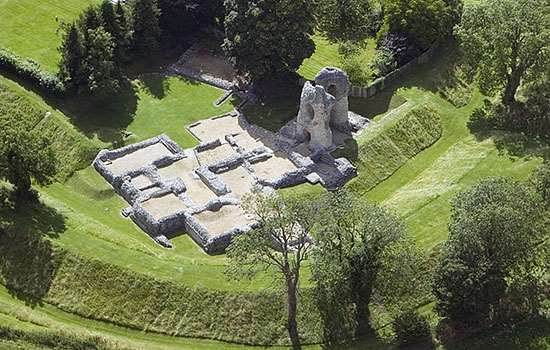Dating from the 14th century, the cross may have originally stood in an open market place (now built over) about 50 metres south-west of its current location. The cross would have been a prominent landmark in the small market town of Ludgershall, with its fine sculpture illustrating scenes from the resurrection of Jesus, and with the new cross perhaps paid for or supported by the royal patronage of Edward III (reigned 1327–77). King Edward III and Queen Philippa would have stayed in nearby Ludgershall Castle around this time and Ludgershall became an economically and culturally important small town in the region.
The cross was probably about 6 or 7 metres high, with a tall octagonal shaft rising from the (surviving) base, like the Beaumond Cross in Nottinghamshire. Many English towns had this sort of cross in the Middle Ages, situated in a market or prominent place, and acting as a focus for both religious processions and trade.
Most of these crosses were taken down or damaged during England’s Reformation in the 16th century or during the religious changes that accompanied the 17th-century Civil War.
The east face
The Ludgershall Cross is remarkable for its fine medieval decoration. Carved into each face of the square shaft-base is an elaborate niche, and within each niche is a sculptural scene. Although the carving is now much weathered, three of the four scenes can still be recognised.
The east face (facing the pavement and pub) depicts the Descent from the Cross – the lowering of Jesus’ corpse from the cross. The cross is clearly visible, with Mary on the left, touching her son, and John to the right, probably holding a Bible. Two smaller figures, Nicodemus and Joseph of Arimathea, lift Jesus’ body down from the cross. The kneeling figure of Nicodemus is removing the final nail that fixes Jesus’ corpse to the cross.
South, west and north faces
The scene on the south panel, with a tall central figure standing between two smaller figures, has previously been identified as the Three Marys (Mary Magdalene and two other Marys, probably including Mary of Clopas but not necessarily including Jesus’ mother). It has been suggested[1] that this is more convincingly identified as the ‘Road to Emmaus’ scene in which the resurrected Jesus (the taller figure) meets two disciples (the smaller figures either side) after his death.
The west face (facing the road) shows a cave-like structure occupied by four identical figures with their arms raised upwards. Outside the cave and facing them is a well-preserved figure who holds his right arm upwards, perhaps holding a rod or lance. This looks very much like a Harrowing of Hell scene, in which Jesus breaks open the gates of hell with a lance.
The scene on the north side of the cross (facing the castle) is particularly hard to identify, but perhaps depicts Jesus in an Ascension scene, as Christ rising to heaven.
Top image © Greg Balfour Evans/Alamy Stock Photo
Footnotes
Related content
-

History of Ludgershall Castle
Probably begun in the late 11th century by a sheriff of Wiltshire, Ludgershall was much improved in the 13th century by King John and his son Henry III, who used the castle as a hunting lodge.
-

English medieval castles
Discover the stories held within the walls of England’s greatest fortifications and learn about the rise and fall of the medieval castle.
-

More histories
Delve into our history pages to discover more about our sites, how they have changed over time, and who made them what they are today.

